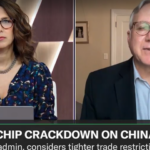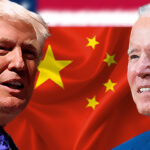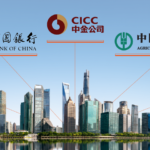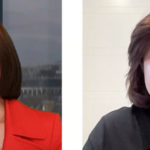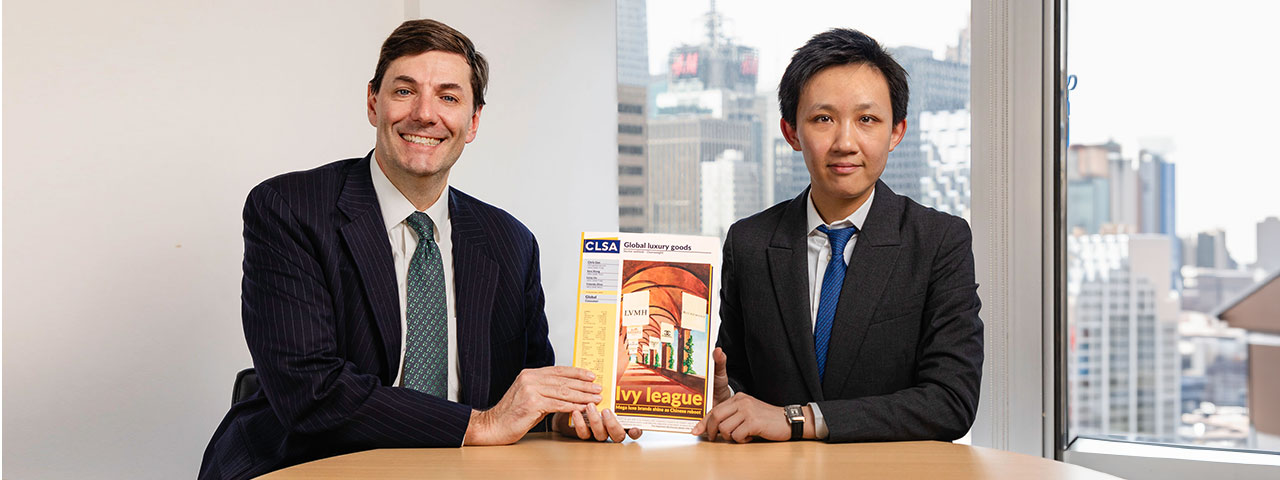
Top Trends Driving Global Luxury: Overview of Our Conversation with CLSA’s Chris Gao
Few analysts understand the nuances of the luxury sector like CLSA’s Chris Gao. On her recent trip to the U.S. from Hong Kong, Chris visited our New York City office to join KraneShares CIO Brendan Ahern on a webinar discussing her independent research and key drivers for the global luxury market.
We have summarized the key highlights of the discussion and provided the video replay below.
Key takeaways from Gao’s discussion:
- There is a structural repatriation trend in China's luxury market, with domestic spending expected to rise from 32% to 70% of total luxury spending by 2025.1
- Women and the younger generation are becoming more prominent in China’s luxury market, with brands adjusting their strategies to cater to their preferences.
- The beauty and makeup sectors serve as an entry point for aspirational consumers to enter the luxury market.
- China's luxury sector is rapidly closing the gap with Europe, fueled by the country's burgeoning affluent class and evolving consumer preferences.
- For investors seeking exposure to the global luxury market, the KraneShares Global Luxury ETF (ticker: KLXY) offers access to leading luxury companies worldwide.
Click the image below to view the replay:
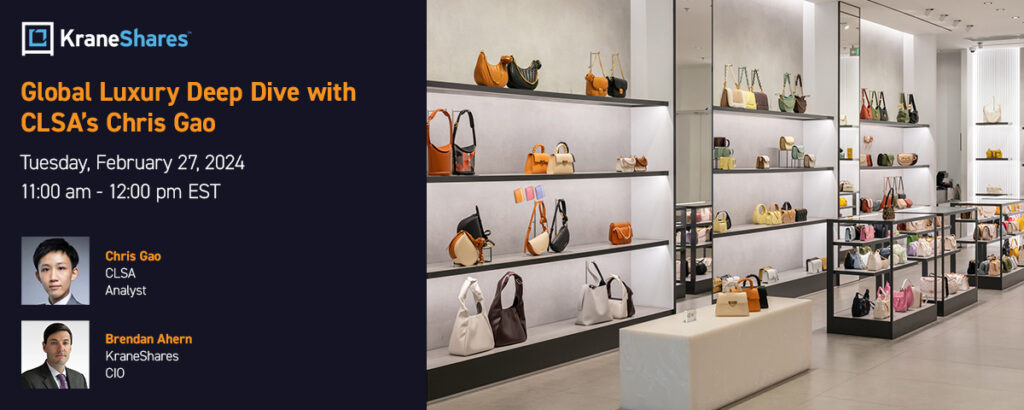
Structural Shift Towards Domestic Spending in China's Luxury Market
Chris Gao's insights highlighted the significant transformation in China's luxury market, particularly in the post-COVID-19 era. She emphasized a notable shift towards domestic spending, departing from previous trends in buying luxury goods abroad. Gao stated, "We believe Chinese luxury spending repatriation is structural. Pre-Covid, 32% of Chinese spending was onshore; we believe this figure will be 70% by 20252." This internal trend reflects a sharp increase in luxury brands focusing on local market penetration and branding.
Gao stated that brands are renovating and expanding flagship stores in premium locations, e.g., Hermès in The Peninsula Beijing. Luxury brands are also exploring opportunities in emerging lower-tier cities by connecting with new projects and experienced landlords (e.g., Chengdu SKP) and finding new locations (e.g., Chanel entering Zhengzhou David Plaza at the end of 2023). Hainan, often referred to as the Hawaii of China, specifically, has prospered far beyond just duty-free (tax benefit) shopping to all sorts of luxury, including new lifestyle and entertainment infrastructure, which has increased foot traffic and sales.
Additionally, Gao highlighted how the pandemic accelerated the localization efforts of luxury brands in China. With the outbreak disrupting global supply chains and travel restrictions limiting international tourism, luxury brands had to pivot quickly to cater to local consumers. Gao noted that luxury brands redirected resources towards localized marketing strategies, including enhanced communication and customer relationship management (CRM) initiatives tailored to Chinese consumers.
She emphasized, "This trend has been driven by product supply improvement as the local client base in China becomes significantly larger. We have seen localized product offerings, engagement, omnichannel prevalence, and more store openings in the past three years, with selective expansion ongoing and continued narrowing price gaps versus foreign markets." This strategic shift underscores the importance of agility and responsiveness in the luxury sector as brands strive to meet evolving consumer preferences and market conditions.
Demographic Trends and Consumer Profile Shift Driving Luxury Consumption in China
Chris Gao's analysis then delved into the demographic shifts driving luxury consumption in China, emphasizing the evolving preferences of different consumer segments. One key demographic trend she emphasized is the rising prominence of the younger generation and women in the luxury market. Gao pointed out that younger consumers, particularly those aged 20 to 29, display an increasing interest and propensity to spend on luxury goods. This demographic shift departs from traditional consumption patterns and reflects China's youth changing aspirations and lifestyles. Gao remarked, "This demographic shift reflects changing consumer preferences and the emergence of a new generation of luxury consumers in China.”
Moreover, Gao highlighted the growing purchasing power of women in the luxury sector, marking a significant shift in consumer behavior. Women increasingly drive luxury consumption in China, indicating a broader trend toward gender diversity in purchasing patterns. Gao stated, “As more women enter the workforce and achieve financial independence, they are exerting greater influence over luxury spending decisions.” Gao's insights underscore the importance of catering to the preferences and aspirations of both younger consumers and women in shaping the future of the luxury market in China.
Beauty and Makeup Sector as an Entry Point to Luxury Consumption
Gao also pointed out the significance of the beauty and makeup sector as a gateway for aspirational consumers to enter the luxury market. She noted that cosmetics and skincare products serve as accessible entry points for consumers seeking to experience luxury brands at a more affordable price point. Gao remarked, "The beauty and makeup sector is an accessible entry point for aspirational consumers to participate in the luxury movement." Luxury beauty products offer all consumers the opportunity to indulge in premium brands and enjoy the prestige associated with luxury without the high price tag of other products.
Furthermore, Gao highlighted that “by democratizing luxury consumption through beauty and makeup products, luxury brands can expand their customer base and cultivate brand loyalty among a broader audience.” Her insights underscore the transformative role of the beauty and makeup sector in shaping consumer behavior and driving growth in the luxury market in China.
China’s Luxury Sector is Closing the Gap with Europe
Gao's analysis also covered the transformative shifts occurring within China's luxury sector post-COVID, highlighting its growing competitiveness on the global stage, particularly in comparison to Europe. Gao emphasized that China’s domestic market was bolstered by pandemic-related travel restrictions, which forced luxury brands to offer more competitive pricing within China compared to traditional luxury hubs in Europe. She noted, "China's luxury sector is rapidly closing the gap with Europe, driven by robust domestic demand and strategic initiatives by luxury brands to cater to Chinese consumers."
Gao elaborated on how China's luxury sector has experienced exponential growth in recent years, fueled by the country's burgeoning affluent class and evolving consumer preferences. She stated, "The spending power of Chinese consumers, coupled with their increasing appetite for luxury goods, has positioned China as a key driver of global luxury sales." This trend underlines the shifting dynamics of the luxury market, with China's influence expanding beyond its borders.
Outlook
In 2024, China's economic engine continues to drive growth, with the global personal luxury goods sector poised to achieve a 5% year-over-year increase, reaching a market size of €381 billion.3 The main driver of this growth remains the Chinese clientele, with a forecasted mid-teen compound annual growth rate (CAGR) of 15% from 2022 to 2025, returning to pre-COVID levels by 2025.4 Chinese cohort spending is anticipated to rise by 10% year-over-year in 2024, reaching €88 billion, propelled by the recovery of outbound travel and stable onshore market growth.5 This growth is expected to be supported by a gradual relaxation of visa policies, airline capacity recovery, and increased penetration into lower-tier cities. Gao believes the outlook for the Chinese luxury market remains robust, with all worst-case scenarios stemming from the pandemic already factored in.
For those interested in gaining exposure to the global luxury market, the KraneShares Global Luxury ETF (ticker: KLXY) offers a compelling investment, providing access to leading luxury companies worldwide.
BIO
Chris Gao joined CLSA in 2021 as an analyst covering the consumer sector, focusing on discretionary spaces, including European luxury goods within the global consumer regime and apparel, cosmetics, and retail within the Chinese consumer regime. She started covering the luxury goods space in 2019 in China Renaissance Securities, featuring a Chinese side of the luxury story. Back then, she was the earliest Chinese analyst who was based in greater China to cover the sector. She previously worked at Daiwa Capital Markets, where she covered Macau Gaming, and at DBS Vickers Securities, where she covered China/Hong Kong healthcare. Chris holds a bachelor’s degree in business administration from the University of Hong Kong.
For KLXY standard performance, top 10 holdings, risks, and other fund information, please click here.
This should not be regarded as investment advice or a recommendation of specific securities. Holdings are subject to change. Securities mentioned do not make up the entire portfolio and, in the aggregate, may represent a small percentage of the fund.
Citations:
- Bain & Company and CLSA research as of 2/29/24.
- CLSA research as of 2/29/24.
- CLSA research as of 2/29/24.
- CLSA research as of 2/29/24.
- CLSA research as of 2/29/24.
Definitions:
Market Size: The "market size" is made up of the total number of potential buyers of a product or service within a given market, and the total revenue that these sales may generate.
Compound Annual Growth Rate (CAGR): The compound annual growth rate, or CAGR, of an investment or other unit of value is the average annual amount it grows over a period of years assuming profits are reinvested during the period. In other words, it breaks an investment's total return over a number of years into a single average rate.
Cohort Spending: A customer cohort is a group of customers who share a particular characteristic or set of characteristics. These characteristics can range from the time they started using a product or service, demographics, purchasing behavior, or any other defining trait.

